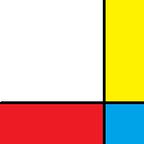Goya: Transition into the Dark
1792年戈雅因病耳聋,再加上此时政府无能、社会动荡,戈雅的内心也发生了巨大的转变。他开始创作讽刺性版画,用各种稀奇古怪的人物来讽刺教会和国家。
In 1792, Goya was deaf due to illness, coupled with the government’s incompetence and social turmoil at this time, Goya’s heart also changed dramatically. He began to create satire prints, using various strange characters to satirize the church and the country.
这幅《理性沉睡,心魔生焉》为戈雅《狂想曲》(Los Caprichos)系列80幅铜版画中的第43幅。画面主人公(即戈雅)埋头沉睡,象征愚蠢的猫头鹰和象征无知的蝙蝠围绕周围、伺机攻击。作品极富盛名,标题亦被经常引用。
This “The Sleep of Reason Produces Monsters” is the 43rd in the 80 copperplate prints of Goya’s “Los Caprichos” series. The protagonist of the picture (that is, Goya) is buried in a deep sleep, symbolizing a stupid owl and a bat symbolizing ignorance, attacking around and waiting for opportunities. The work is very famous, often quoted and referenced by others.
1808年拿破仑入侵西班牙,半岛战争爆发了。戈雅绘制了《1808年5月2日》以及《1808年5月3日》两幅油画来纪念西班牙在半岛战争中的顽强抵抗。戈雅不再采用以往和谐、柔和的色彩,转而使用暗色调。画面描绘出了战争的惨烈,死亡的可怖,毫不掩饰地展现了冲突、暴力、鲜血。
Napoleon invaded Spain in 1808 and the Peninsular War broke out. Goya painted two oil paintings “The Second of May 1808” and “The Third of May 1808” to commemorate Spain’s tenacious resistance in the Peninsular War. Goya no longer uses the harmonious and soft colors in the past, but uses dark colors. The picture depicts the tragic war, the terrible death, and unabashedly shows the conflict, violence, and blood.
两幅作品与基督教传统艺术和描绘战争的传统绘画大相径庭,因此也被认为是最早的现代绘画作品,具有革命性意义。
The two works are very different from traditional Christian art and the conventional paintings depicting wars, so they are considered to be the earliest modern paintings and have revolutionary significance.
戈雅晚年搬入了一幢两层小楼 — — “聋人之家”(Quinta del Sordo)。在经历了政府的腐败、战争的残忍、社会的动荡之后,戈雅彻底对世界失望了。他在房间内绘制了一系列壁画(被后世称为“黑色绘画”),以阴森可怖的题材为主,用暗色调(黑色、白色、灰色、深红色等)进行描绘,以此来表现他内心的孤独、寂寞,表达对社会的厌恶,对人类的绝望。在他离世后,他的朋友安东尼奥布鲁加达(Antonio Brugada)对这些作品进行了分类,学者们将画作从墙壁上“移”到了画布上,目前展出于普拉多博物馆中。
In his later years, Goya moved into a two-story building — — “Quinta del Sordo”. After experiencing government corruption, cruel war, and social unrest, Goya was utterly disappointed in the world. He drew a series of murals (called “black paintings” in later generations) in the room, focusing on eerie subjects and depicting them in dark tones (black, white, gray, crimson, etc.). The loneliness in his heart expresses his aversion to society and despair of mankind. After his death, his friend Antonio Brugada classified these works, and scholars “moved” the painting from the wall to the canvas, which is currently on display in the Prado Museum.
黑色绘画由14幅作品组成 (“black paintings ” consists of 14 pieces):Atropos (The Fates), Two Old Men, Two Old Men Eating Soup, Fight with Cudgels, Witches’ Sabbath, Men Reading, Judith and Holofernes, A Pilgrimage to San Isidro, Women Laughing, Procession of the Holy Office, The Dog, Saturn Devouring His Son, La Leocadia, and Fantastic Vision.
这幅《萨图尔努斯吞噬其子》为“黑色绘画”系列中最为阴暗恐怖的一幅。描绘的是古希腊罗马神话中的农神萨图尔努斯为了防止儿子们夺权篡位,故而将孩子们全部吃掉的故事。戈雅或许是想借这幅作品来暗讽政府的黑暗,当权者为了权力和财富压榨民众与萨图尔努斯吞噬其子并无二至。
This “Saturn Devouring His Son” is the darkest and most horrifying one in the “black painting” series. It depicts Saturnus, the goddess of agriculture in ancient Greek and Roman mythology, to prevent the sons from seizing power and usurping the throne, so they ate all the children. Goya may want to use this work to mention the darkness of the government. The power-holders squeeze the people for power and wealth, and Saturnous devours his son.
从《阳伞》到《萨图尔努斯吞噬其子》,戈雅经历了太多,也变了太多。他的影响力穿越二十世纪,至今仍能引起共鸣。他从未建立自己的门派,但他的作品对后来的现实主义绘画、浪漫主义绘画,乃至印象派都带来了很大影响。
From “The Parasol” to “Saturn Devouring His Son”, Goya has experienced too much and has changed too much. His influence traversed the twentieth century and still resonates today. He never established his own school, but his works greatly influenced realism paintings, romantic paintings, and even impressionism.
